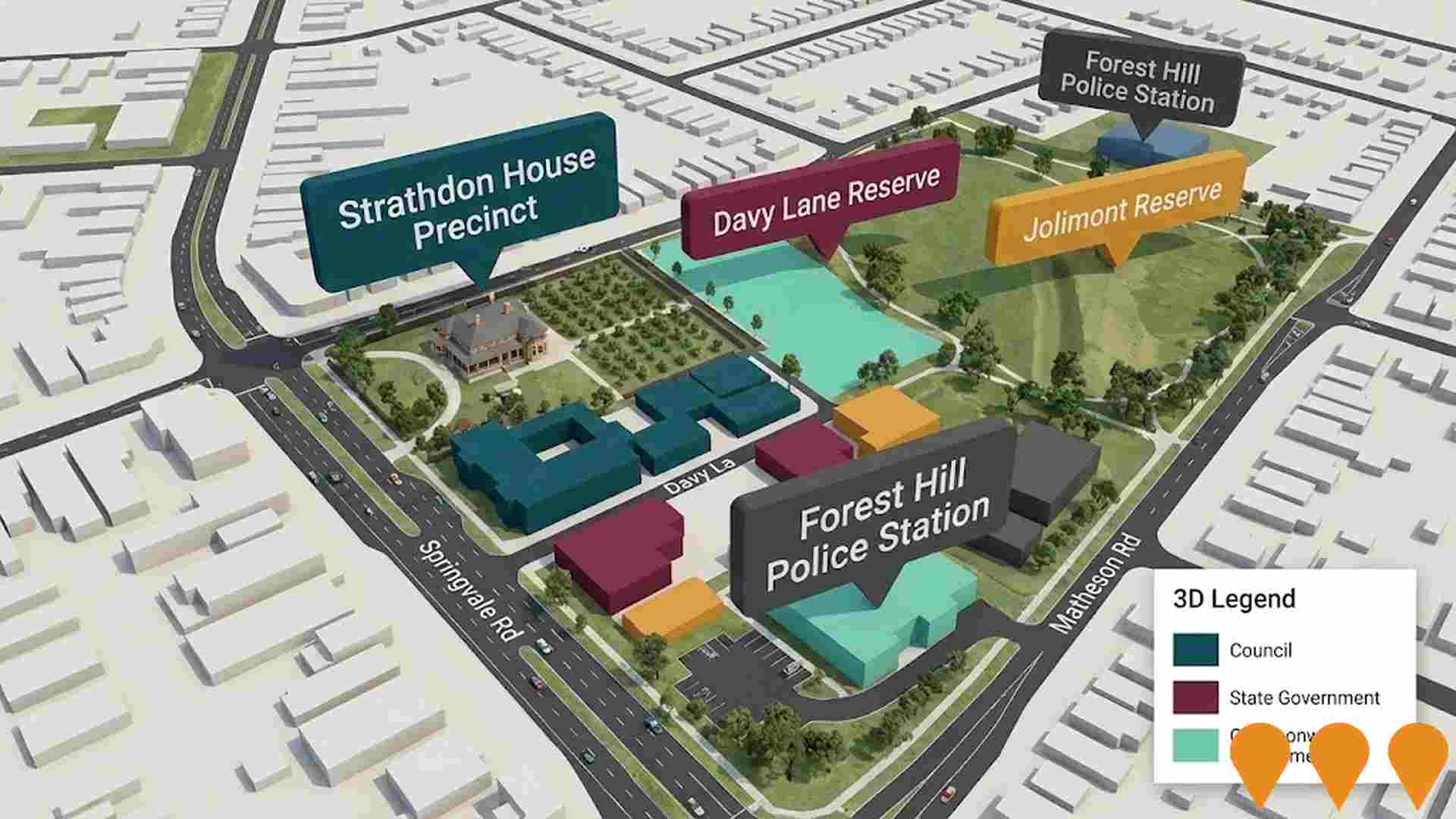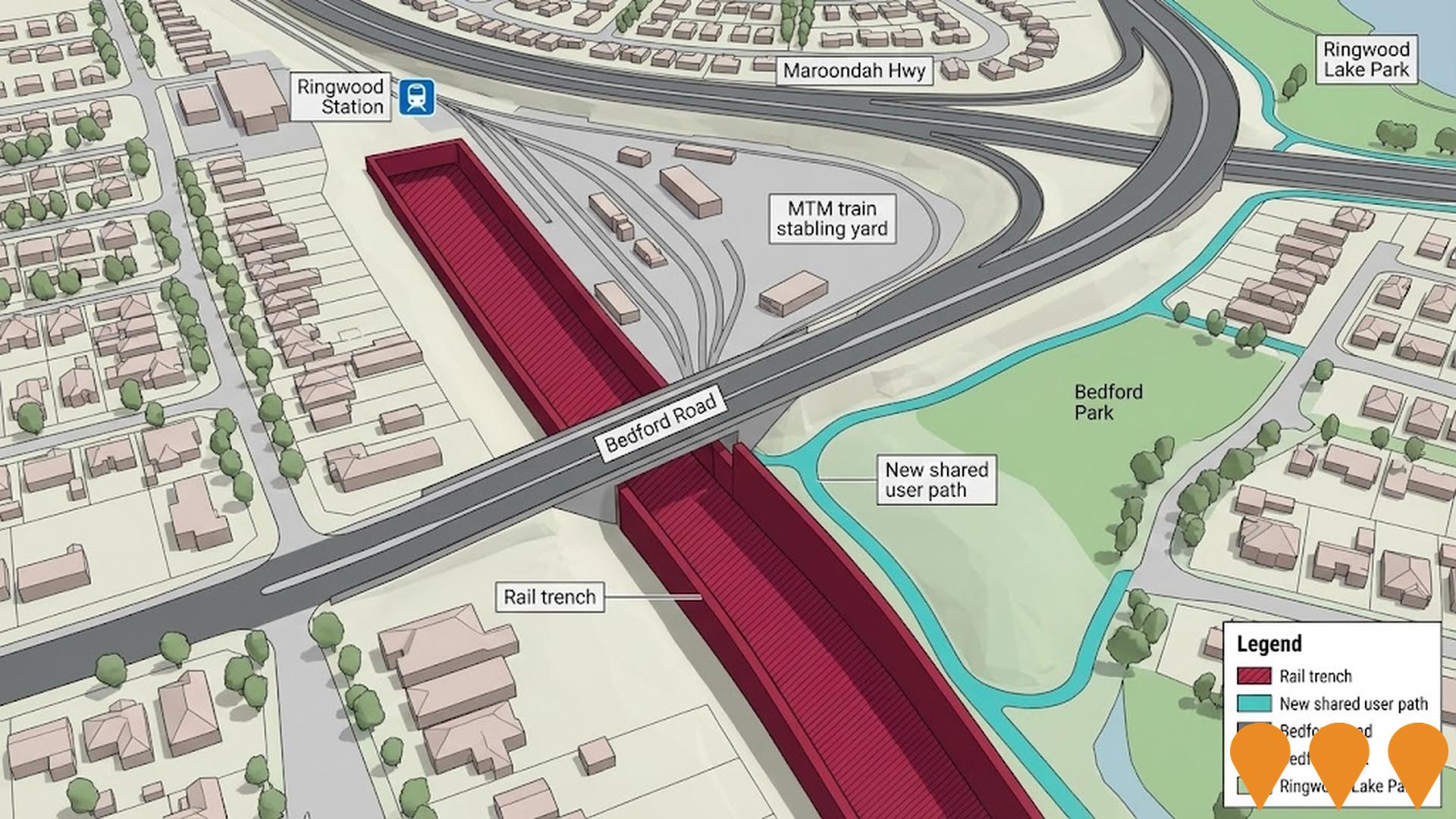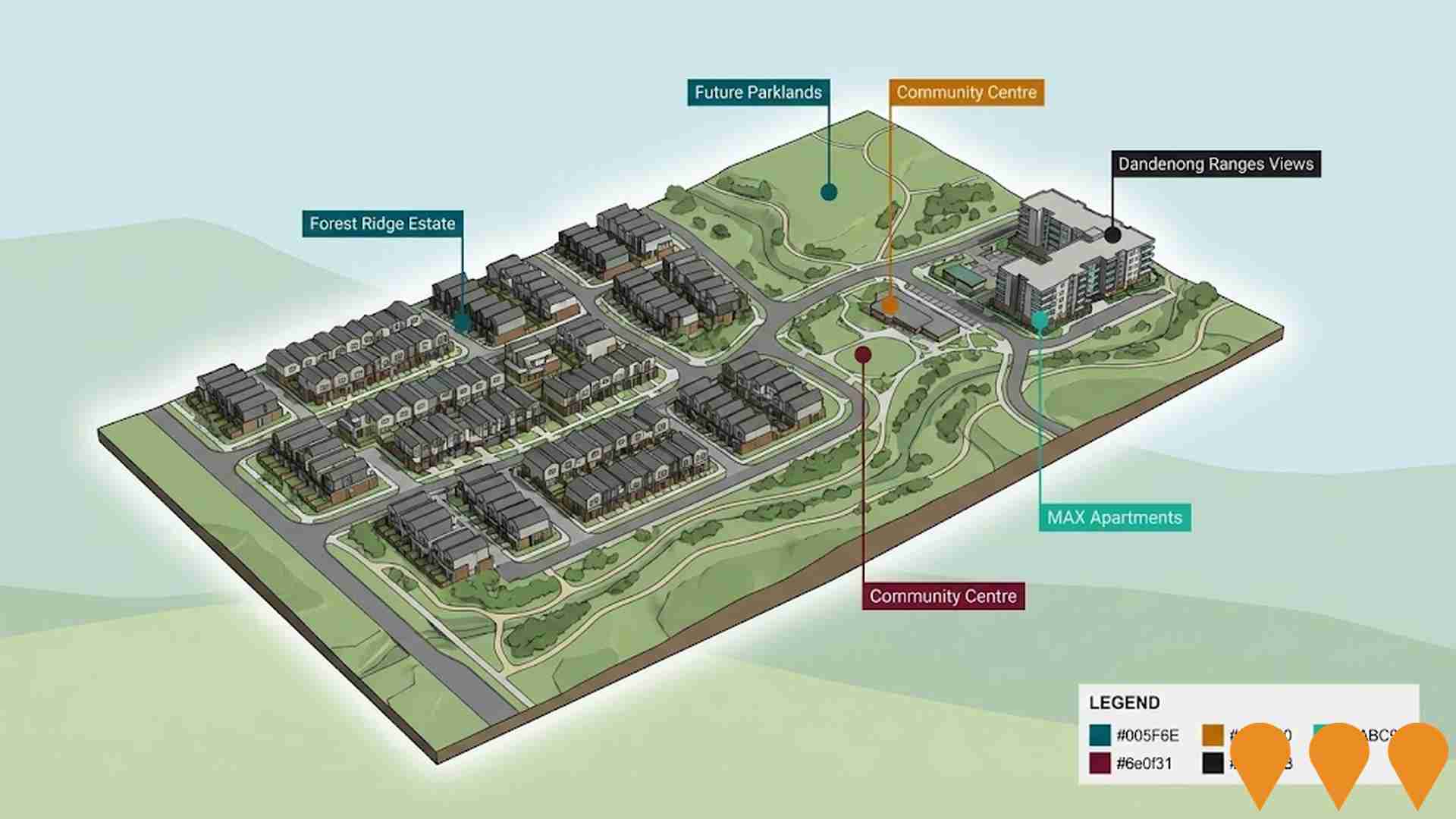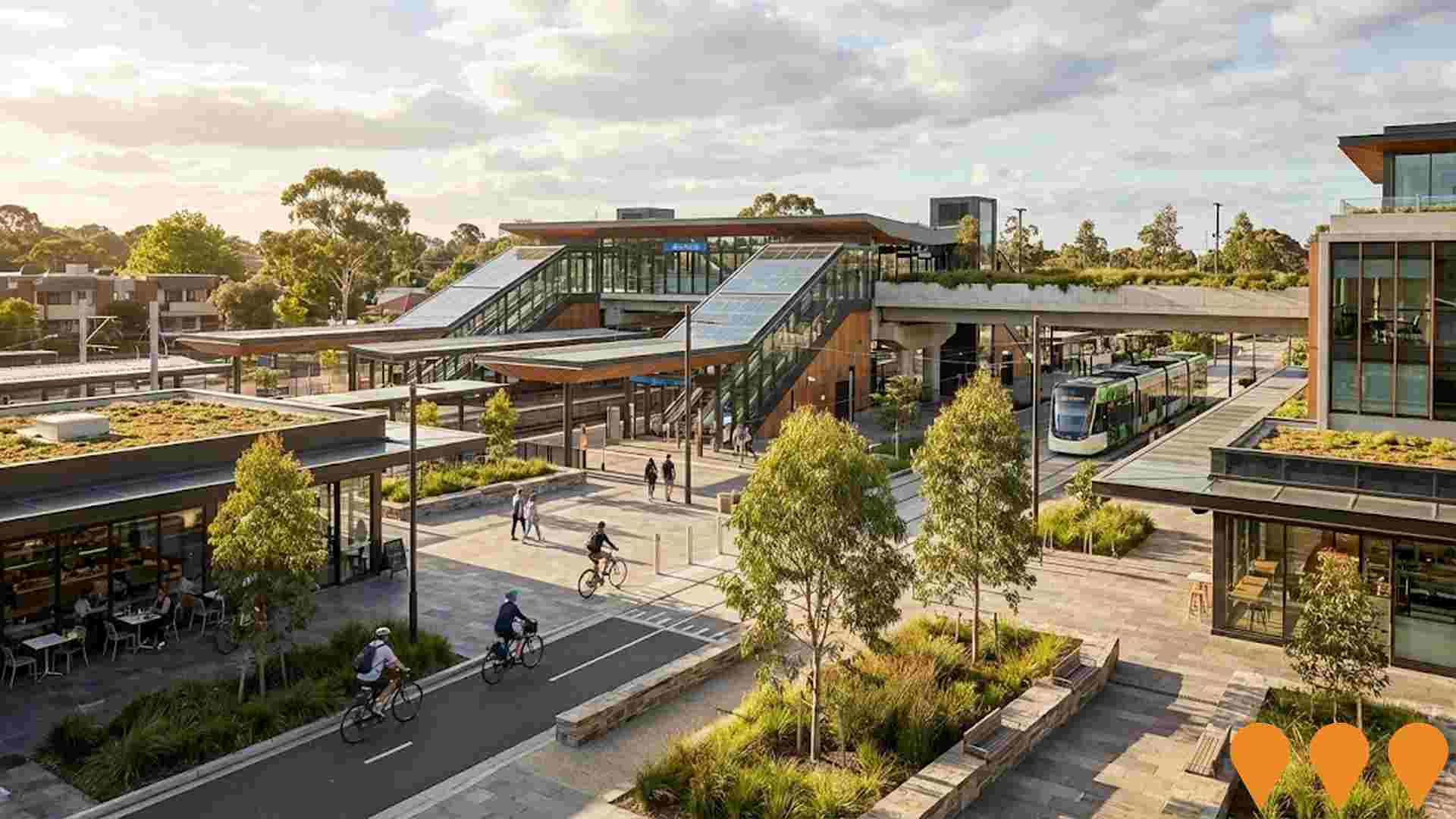Chart Color Schemes
est. as @ -- *
ABS ERP | -- people | --
2021 Census | -- people
Sales Activity
Curious about local property values? Filter the chart to assess the volume and appreciation (including resales) trends and regional comparisons, or scroll to the map below view this information at an individual property level.
Find a Recent Sale
Sales Detail
Population
Population growth drivers in Mitcham are strong compared to national averages based on AreaSearch's ranking of recent, and medium to long-term trends
Based on AreaSearch's analysis, Mitcham Vic.'s population is around 17,512 as of Aug 2025. This reflects an increase of 717 people (4.3%) since the 2021 Census, which reported a population of 16,795 people. The change is inferred from the estimated resident population of 17,472 from the ABS as of June 2024 and an additional 126 validated new addresses since the Census date. This level of population equates to a density ratio of 2,641 persons per square kilometer, placing it in the upper quartile relative to national locations assessed by AreaSearch. Mitcham's 4.3% growth since the 2021 census exceeded the SA4 region (3.9%), marking it as a growth leader in the region. Population growth for the area was primarily driven by overseas migration that contributed approximately 73.3% of overall population gains during recent periods.
AreaSearch is adopting ABS/Geoscience Australia projections for each SA2 area, released in 2024 with 2022 as the base year. For any SA2 areas not covered by this data, AreaSearch is utilising the VIC State Government's Regional/LGA projections released in 2023 with adjustments made employing a method of weighted aggregation of population growth from LGA to SA2 levels. Growth rates by age group from these aggregations are also applied across all areas for years 2032 to 2041. Considering the projected demographic shifts, an above median population growth of statistical areas across the nation is projected, with the area expected to grow by 2,603 persons to 2041 based on the latest population numbers, recording a gain of 14.6% in total over the 17 years.
Frequently Asked Questions - Population
Development
Residential development activity is lower than average in Mitcham according to AreaSearch's national comparison of local real estate markets
Mitcham has recorded approximately 54 residential properties granted approval annually. Over the past five financial years, from FY21 to FY25, around 273 homes were approved, with an additional 72 approved in FY26 so far. The average number of new residents per year per dwelling constructed over these five years was 0.7.
This suggests that new construction is meeting or exceeding demand, providing more options for buyers and enabling population growth that could surpass current projections. The average value of new properties being constructed is $660,000, which is somewhat higher than regional norms, indicating quality-focused development. In FY26, there have been approximately $8.5 million in commercial approvals, suggesting limited focus on commercial development compared to residential. Compared to Greater Melbourne, Mitcham shows similar development activity per person, maintaining market balance with the broader area.
However, this activity is below average nationally, reflecting the area's maturity and potentially indicating planning constraints. Recent construction comprises 62% standalone homes and 38% townhouses or apartments, offering a range of medium-density options across various price brackets. Mitcham has approximately 378 people per dwelling approval, indicative of an established area. Looking ahead, Mitcham is projected to grow by 2563 residents by 2041. If current development rates continue, housing supply may not keep pace with population growth, potentially increasing competition among buyers and supporting stronger price growth.
Frequently Asked Questions - Development
Infrastructure
Mitcham has very high levels of nearby infrastructure activity, ranking in the top 20% nationally
Changes to local infrastructure significantly impact an area's performance. AreaSearch identified 19 projects that could affect the region. Notable initiatives include McDowell Street Social Housing (26-32), Mitcham Station Precinct Enhancement, Glenburnie Road Residences (42-48), and Dudley Street Townhouses (26). The following list details those most relevant:.
Professional plan users can use the search below to filter and access additional projects.
INFRASTRUCTURE SEARCH
 Denotes AI-based impression for illustrative purposes only, not to be taken as definitive under any circumstances. Please follow links and conduct other investigations from the project's source for actual imagery. Developers and project owners wishing us to use original imagery please Contact Us and we will do so.
Denotes AI-based impression for illustrative purposes only, not to be taken as definitive under any circumstances. Please follow links and conduct other investigations from the project's source for actual imagery. Developers and project owners wishing us to use original imagery please Contact Us and we will do so.
Frequently Asked Questions - Infrastructure
Strathdon House Davy Lane Jolimont Reserve Precinct Master Plan
A comprehensive master plan for Strathdon House, Davy Lane Reserve, and Jolimont Reserve that will guide development over the next 10-15 years. The plan focuses on historic preservation of the 1893 Strathdon House and heritage orchard, enhancement of recreational open spaces including sports fields for cricket and AFL, walking paths, community gardens, native vegetation conservation, and facilities for both passive and active recreation. The site serves as the western gateway to the former Healesville Freeway Reserve and aims to balance environmental values with increased community recreational opportunities. The draft master plan is being developed in 2025 with community consultation planned for early 2025.

Bedford Road Level Crossing Removal
Removal of dangerous and congested level crossing by building 380m rail trench under Bedford Road. Part of Level Crossing Removal Project making Belgrave Line level crossing free between city and Ferntree Gully. New walking and cycling path connecting 19.2km Heathmont Rail Trail to Bedford Park. Over 60,000 native trees, plants and grasses planted. Boom gates were down for up to 23 minutes during peak periods before removal, affecting 13,500 vehicles daily.

26-32 McDowall Street Social Housing
Development of 62 social housing dwellings at the former RSL site by Community Housing (Victoria) Limited in partnership with Homes Victoria. Part of Victoria's Big Housing Build program, the four-storey apartment building provides affordable housing with 11 one-bedroom, 46 two-bedroom, and 5 three-bedroom dwellings, plus basement parking for 37 cars, 21 bicycle spaces, communal outdoor area with BBQ and garden, and a rainwater tank. Construction is underway as of July 2025.

Mitcham Child Care Centre
Approved childcare development on a 1,397-1,400 sqm site. In July 2024 an amendment to planning permit WH/2021/1142 proposed a revised design and reduced capacity from 98 to 91 places. ASL Real Estate marketed the brand-new, permitted 91-place centre for lease and reports the tenancy as leased in June 2025. Ongoing council records should be checked for construction/operational milestones.

Forest Ridge
A large-scale masterplanned community on a 9-hectare former television studio site, featuring approximately 700 dwellings including townhouses and the MAX apartment development. The project includes extensive parklands, nature trails, and views over the Dandenong Ranges, with stages progressively developed since 2018. The MAX apartment building offers 115 oversized 1-3 bedroom residences with premium finishes, rooftop amenities, and sustainable design features.

Mitcham Station Precinct Enhancement
Enhancement of the Mitcham Station precinct including improved pedestrian facilities, public spaces, and integration with surrounding developments. The project aims to create a more vibrant and accessible station area through new public spaces, better pedestrian and cycling movement, and revitalization via new development and landscaping.

Nunawading Activity Centre Cluster
Strategic planning initiative and part of the Victorian Government's expanded 50 train and tram zone activity centres program to transform the Nunawading activity centre. The Nunawading Cluster includes Blackburn, Nunawading, and Mitcham stations precinct development with enhanced public transport integration, mixed-use development, improved connectivity between train and tram services, increased housing density, and commercial facilities.

Kyra Residences
Kyra Residences is a boutique collection of eighteen spacious three and four bedroom luxury townhouses located in the heart of leafy Mitcham, showcasing timeless architecture with clean lines, minimalist aesthetics, and light-filled spaces with elegantly appointed interiors.

Employment
The labour market in Mitcham shows considerable strength compared to most other Australian regions
Mitcham Vic features highly educated workforce with strong professional services representation, unemployment rate of 2.6%, and estimated employment growth of 0.6% over the past year as of June 2025. Residents in work totalled 9,889 with an unemployment rate of 2.0% below Greater Melbourne's 4.6%.
Workforce participation was 67.4%, comparable to Greater Melbourne's 64.1%. Employment concentrations were health care & social assistance, professional & technical, and education & training. Notably, professional & technical employment was 1.3 times the regional average while transport, postal & warehousing showed lower representation at 2.8% versus regional average of 5.2%. Many residents commute elsewhere for work based on Census working population to local population count.
Over June 2024 to June 2025, employment increased by 0.6%, labour force by 0.7%, keeping unemployment stable at 3.1%. In Greater Melbourne, employment grew by 3.5%, labour force expanded by 4.0%, and unemployment rose to 3.9%. Jobs and Skills Australia's national employment forecasts from May 2025 project national employment growth of 6.6% over five years and 13.7% over ten years, with varying rates between industry sectors. Applying these projections to Mitcham's employment mix suggests local growth of approximately 6.9% over five years and 14.1% over ten years.
Frequently Asked Questions - Employment
Income
The area exhibits notably strong income performance, ranking higher than 70% of areas assessed nationally through AreaSearch analysis
AreaSearch reports median taxpayer income in Mitcham was $56,319 during financial year 2022. Average income stood at $73,886. Nationally, median and average incomes were $54,892 and $73,761 respectively for Greater Melbourne. As of September 2025, estimates suggest median and average incomes would be approximately $63,167 and $82,871 based on Wage Price Index growth of 12.16% since financial year 2022. Mitcham's household, family, and personal incomes clustered around the 68th percentile nationally according to the 2021 Census. Income analysis showed 30.1% (5,271 individuals) earned between $1,500 and $2,999 weekly, reflecting regional trends where 32.8% fall within this bracket. Mitcham exhibits affluence with 31.2% earning over $3,000 per week, supporting premium retail and service offerings. After housing expenses, 85.4% of income remains for other costs. The area's SEIFA income ranking places it in the 8th decile.
Frequently Asked Questions - Income
Housing
Mitcham displays a diverse mix of dwelling types, with a higher proportion of rental properties than the broader region
Dwelling structure in Mitcham, as evaluated at the latest Census, comprised 62.9% houses and 37.1% other dwellings. In comparison, Melbourne metro had 73.0% houses and 26.9% other dwellings. Home ownership in Mitcham was 35.6%, with mortgaged dwellings at 36.4% and rented dwellings at 28.0%. The median monthly mortgage repayment in Mitcham was $2,167, below Melbourne metro's average of $2,200. Median weekly rent in Mitcham was $406, compared to Melbourne metro's $410. Nationally, Mitcham's mortgage repayments were higher than the Australian average of $1,863, and rents exceeded the national figure of $375.
Frequently Asked Questions - Housing
Household Composition
Mitcham has a typical household mix, with a lower-than-average median household size
Family households constitute 71.2% of all households, including 35.2% couples with children, 25.4% couples without children, and 9.4% single parent families. Non-family households account for the remaining 28.8%, with lone person households at 25.3% and group households comprising 3.6%. The median household size is 2.5 people, which is smaller than the Greater Melbourne average of 2.6.
Frequently Asked Questions - Households
Local Schools & Education
Educational achievement in Mitcham places it within the top 10% nationally, reflecting strong academic performance and high qualification levels across the community
Educational attainment in Mitcham exceeds broader benchmarks. Among residents aged 15+, 44.9% hold university qualifications, compared to 30.4% nationally and 31.2% regionally. Bachelor degrees are most prevalent at 28.3%, followed by postgraduate qualifications (12.0%) and graduate diplomas (4.6%). Vocational pathways account for 24.2%, with advanced diplomas at 11.1% and certificates at 13.1%.
Educational participation is high, with 28.1% currently enrolled in formal education. This includes 8.9% in primary, 6.8% in secondary, and 5.8% in tertiary education. Mitcham's five schools have a combined enrollment of 2,481 students as of the latest data. The area shows significant socio-educational advantages with an ICSEA score of 1116. Educational provision is balanced with four primary schools and one secondary school serving distinct age groups.
Frequently Asked Questions - Education
Schools Detail
Nearby Services & Amenities
Transport
Transport servicing is high compared to other areas nationally based on assessment of service frequency, route connectivity and accessibility
Public transport analysis reveals 94 active transport stops operating within Mitcham. These comprise a mix of train and bus services. They are serviced by 26 individual routes which collectively provide 10,115 weekly passenger trips.
Transport accessibility is rated as excellent with residents typically located 188 meters from the nearest transport stop. Service frequency averages 1,445 trips per day across all routes, equating to approximately 107 weekly trips per individual stop.
Frequently Asked Questions - Transport
Transport Stops Detail
Health
Mitcham's residents are extremely healthy with both young and old age cohorts seeing low prevalence of common health conditions
Analysis of health metrics shows strong performance throughout Mitcham with both young and old age cohorts seeing low prevalence of common health conditions. The rate of private health cover is very high at approximately 56% of the total population (9894 people), compared to 54.2% across Greater Melbourne.
The most common medical conditions in the area are asthma and mental health issues, impacting 7.9% and 7.4% of residents respectively. 72.6% of residents declare themselves completely clear of medical ailments, compared to 72.3% across Greater Melbourne. Mitcham has 16.7% of residents aged 65 and over (2922 people), which is lower than the 20.4% in Greater Melbourne. Health outcomes among seniors are particularly strong, performing even better than the general population in health metrics.
Frequently Asked Questions - Health
Cultural Diversity
Mitcham is among the most culturally diverse areas in the country based on AreaSearch assessment of a range of language and cultural background related metrics
Mitcham has a high level of cultural diversity, with 34.3% of its population born overseas and 32.6% speaking a language other than English at home. Christianity is the predominant religion in Mitcham, comprising 41.8% of the population. Buddhism, however, is overrepresented in Mitcham compared to Greater Melbourne, making up 3.7% versus 5.3%.
The top three ancestry groups in Mitcham are English (21.7%), Australian (20.2%), and Chinese (14.1%). There are notable differences in the representation of certain ethnic groups: Korean is overrepresented at 0.7% compared to 0.6% regionally, Sri Lankan is at 0.5% versus 0.9%, and Indian is at 3.4% versus 3.9%.
Frequently Asked Questions - Diversity
Age
Mitcham's population is slightly older than the national pattern
The median age in Mitcham is 39 years, which is higher than Greater Melbourne's average of 37 years. It is also close to the national average of 38 years. The 55-64 age cohort is notably over-represented in Mitcham at 11.6%, while the 25-34 year-olds are under-represented at 13.2%. According to post-2021 Census data, the 15-24 age group has grown from 11.1% to 12.0% of Mitcham's population. Conversely, the 25-34 cohort has declined from 14.1% to 13.2%. Population forecasts for 2041 indicate significant demographic changes in Mitcham. The 45-54 age group is expected to grow by 25%, reaching 2938 people from the current 2350. However, both the 0-4 and 35-44 age groups are projected to have reduced numbers.